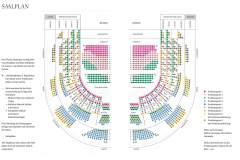The Triptych
June 2026 | ||||||
|---|---|---|---|---|---|---|
Mo | Tu | We | Th | Fr | Sa | Su |
The Triptych – Giacomo Puccini | Opera
Text Giuseppe Adami & Giovacchino Forzano
by Dante Alighieri & Didier Gold
Short Summary
Il tabarro is a gloomy marital drama set in the milieu of Parisian boatmen on the Seine: Grief for their deceased child stands between the couple Michele and Giorgetta, Giorgetta's affair with the worker Luigi ends in tragedy.
Suor Angelica, the "sentimental" story for which Giovacchino Forzano wrote the libretto, tells of the suffering of the eponymous nun, who draws her vitality from the memory of her son - the result of the "misstep" that brought her to this place - until she is robbed of this support.
For the comic third part, Gianni Schicchi, Forzano again adapted a short episode from Dante's Inferno: In order to obtain the inheritance of the rich Florentine Buoso Donati, his relatives instruct Gianni Schicchi to take his place and - as a supposedly dying man - dictate a will in their favor.
Il Tabarro - 55 min
Intermission - 25 min
Suor Angelica - 50 min
Intermission - 25 min
Gianni Schicchi - 55 min
Synopsis
IL TABARRO
Michele's barge is moored in a corner of the Seine in Paris. The workers unload the last of their goods while Michele watches the sunset. Michele's wife Giorgetta offers the workers refreshments. The young worker Luigi beckons an organ grinder. Giorgetta dances first with Tinca, who is happy to drink, and then with Luigi.
The cheerful scene is interrupted by Michele. The relationship between him and his much younger wife is strained. He tells Giorgetta that he wants to keep Luigi employed alongside the older worker Talpa and Tinca, otherwise he will starve to death. Talpa's wife Frugola comes to collect her husband. She dreams of spending the rest of her life in a little house in the country. Giorgetta, on the other hand, raves about the Belleville district of Paris, where she and Luigi come from. When everyone else has left, Giorgetta calls Luigi over. The two have a love affair. They arrange to meet at midnight and Giorgetta lights a match as a signal.
Michele accuses Giorgetta of no longer loving him. He conjures up the time of their happiness, which ended when their child died. The symbol of this happiness is Michele's coat, under which he was able to offer his little family protection. Giorgetta leaves Michele alone with his dark thoughts. He is convinced that she is having an affair and thinks about who her lover might be.
As he lights his pipe, the waiting Luigi takes the match for the agreed sign from Giorgetta and enters the boat. Pressed by Michele, Luigi confesses his love for Giorgetta. Michele stabs him to death. He wraps the body in his coat. Giorgetta comes to apologize to Michele. Michele opens the coat and Luigi's body is revealed.
SUOR ANGELICA
A courtyard inside a convent. After evening mass, Sister Zealot gives some of the sisters penance exercises, while the others go off to their leisure time. When the conversation turns to a deceased sister, Suor Angelica explains that death is a beautiful life in which there are no more wishes.
The sisters are divided as to whether they are allowed to have worldly desires. Most of them deny having any, including Suor Angelica. However, the sisters know that Angelica is eagerly awaiting news of her family. Rumor has it that Angelica comes from a rich, noble family and was sent to a convent as punishment. One of her sisters was stung by wasps. Suor Angelica, who looks after the convent garden, has soothing remedies at hand.
A visitor is reported: It's Angelica's aunt. She has taken over the guardianship of Angelica and her siblings from their deceased parents. Now she has come to present Angelica with documents on the division of the family estate for her to sign, because Angelica's younger sister is getting married. Her future husband is prepared to overlook the disgrace that Angelica has brought upon the family: Angelica has an illegitimate son. She asks her aunt to tell her about him.
The aunt explains that the child died two years ago. She then forces Angelica to sign and leaves the convent. Angelica laments the fate of her child, who had to die without a mother. The unsuspecting sisters congratulate her on the long-awaited visit. At night, Angelica poisons herself. Dying, she falls into despair over the mortal sin of suicide. Surrounded by heavenly choirs and unexpected apparitions, she dies as if in transfiguration.
GIANNI SCHICCHI
Buoso Donati has died. His relatives outdo each other with expressions of grief. The cries are particularly loud when Buoso's will is found: The deceased has left his entire estate to a monastery.
The young Rinuccio suggests asking the clever Gianni Schicchi for advice. Rinuccio's motives are not altruistic: he wants to marry Gianni's daughter Lauretta. Simone and Zita explain that the noble Donatis would never associate with the family of an upstart like Gianni Schicchi.
When Gianni Schicchi arrives with Lauretta, Zita refuses to agree to the wedding because Lauretta is not bringing a dowry. The offended Gianni wants to leave again, but Rinuccio asks him to at least take a look at the will. Lauretta also threatens to commit suicide if the wedding does not go ahead. Gianni Schicchi confirms that nothing can be done about the will. But he has an idea: in the role of the dying Buoso, he will dictate a new will to the notary in favor of the relatives. A fight breaks out over the best shares of the inheritance, the house, the Signa mills and the prestigious mule. One relative after another takes Gianni aside and promises him a reward if he decides in his favor.
The notary records the will. Gianni awards all his relatives a share of the inheritance. However, he bequeaths the house, the mills and the mule to himself - Gianni Schicchi. Gianni reminds the protesting relatives in disguise that, as accomplices, they face severe punishment if the fraud is discovered.
When the notary and witnesses have left, Gianni throws the angry relatives out of the house. Lauretta and Rinuccio are happy: nothing now stands in the way of their wedding. Gianni Schicchi explains to the audience that he has been thrown into hell for this prank. With a respectful reference to the great father Dante, he asks for leniency on account of the good entertainment.
Program and cast
Il tabarro
Michele – Michael Volle
Giorgetta – Nicole Car
Luigi – Arsen Soghomonyan
Tinca – Andrea Giovannini
Talpa – Dan Paul Dumitrescu
Frugola – Monika Bohinec
Musical Director – Lorenzo Viotti
Staging – Tatjana Gürbaca
Set Design – Henrik Ahr
Costumes – Silke Willrett
Lighting – Stefan Bolliger
Costume Assistant – Carl-Christian Andresen
Suor Angelica
Sister Angelica – Nicole Car
The Princess – Violeta Urmana
The Abbess – Monika Bohinec
Mistress of the Novices – Juliette Mars
The Zealous Sister – Daria Sushkova
Sister Genovieffa – Ileana Tonca
The Nursing Sister – Teresa Sales Rebordão
1st Begging Sister – Ana Garotić
Costume Assistant – Carl-Christian Andresen
Gianni Schicchi
Gianni Schicchi – Ambrogio Maestri
Lauretta, his daughter – Nicole Car
Zita, Buoso’s cousin – Violeta Urmana
Rinuccio, Zita’s nephew – Kang Wang
Gherardo, Buoso’s nephew – Andrea Giovannini
Nella, his wife – Anna Bondarenko
Betto di Signa, Buoso’s brother-in-law – Jusung Gabriel Park
Simone, Buoso’s cousin – Dan Paul Dumitrescu
Marco, his son – Attila Mokus
La Ciesca, Marco’s wife – Daria Sushkova
Maestro Spinelloccio, doctor – Hans Peter Kammerer
Amantio di Nicolao, notary – Simonas Strazdas
Vienna State Opera
Public Transport
Subway lines: U1, U2, U4
Trams: 1, 2, D, J, 62, 65
Buses: 59A
Local Railway: Badner Bahn
Stops: Karlsplatz / Opera
Taxi stands are available nearby.
Parking
Parking is only € 6, - for eight hours!
The Wiener Staatsoper and the ÖPARK Kärntner Ring Garage on Mahlerstraße 8, under the “Ringstraßengalerien”, offer the patrons of the Vienna State Opera a new, reduced parking fee. You can park in the Kärntner Ring Garage for up to 8 hours and pay only a flat fee of € 6, -. Just validate your ticket at one of the discount machines inside the Wiener Staatsoper. The normal rate will be charged for parking time greater than 8 hours. The validation machines can be found at the following coat checks: Operngasse, Herbert von Karajan-Platz, and the right and left and balcony galleries.
Important: In order to get the discount, please draw a ticket and do not use your credit card when entering the garage!
After devaluing your ticket in the Wiener Staatsoper you can pay comfortably by credit card or cash at the vending machines.
The machines accept coins and bills up to 50.- Euro. Parking time longer than 8 hours will be charged at the normal rate.
History
The structure of the opera house was planned by the Viennese architect August Sicard von Sicardsburg, while the inside was designed by interior decorator Eduard van der Nüll. It was also impacted by other major artists such as Moritz von Schwind, who painted the frescoes in the foyer, and the famous "Zauberflöten" (“Magic Flute”) series of frescoes on the veranda. Neither of the architects survived to see the opening of ‘their’ opera house: the sensitive van der Nüll committed suicide, and his friend Sicardsburg died of a stroke soon afterwards.
On May 25, 1869, the opera house solemnly opened with Mozart's Don Giovanni in the presence of Emperor Franz Joseph and Empress Elisabeth.
The popularity of the building grew under the artistic influence of the first directors: Franz von Dingelstedt, Johann Herbeck, Franz Jauner, and Wilhelm Jahn. The Vienna opera experienced its first high point under the direction of Gustav Mahler. He completely transformed the outdated performance system, increased the precision and timing of the performances, and also utilized the experience of other noteworthy artists, such as Alfred Roller, for the formation of new stage aesthetics.
The years 1938 to 1945 were a dark chapter in the history of the opera house. Under the Nazis, many members of the house were driven out, pursued, and killed, and many works were not allowed to be played.
On March 12, 1945, the opera house was devastated during a bombing, but on May 1, 1945, the “State Opera in the Volksoper” opened with a performance of Mozart's THE MARRIAGE OF FIGARO. On October 6, 1945, the hastily restored “Theaters an der Wien” reopened with Beethoven's FIDELIO. For the next ten years the Vienna State Opera operated in two venues while the true headquarters was being rebuilt at a great expense.
The Secretary of State for Public Works, Julius Raab, announced on May 24, 1945, that reconstruction of the Vienna State Opera would begin immediately. Only the main facade, the grand staircase, and the Schwind Foyer had been spared from the bombs. On November 5, 1955, the Vienna State Opera reopened with a new auditorium and modernized technology. Under the direction of Karl Böhm, Beethoven’s FIDELIO was brilliantly performed, and the opening ceremonies were broadcast by Austrian television. The whole world understood that life was beginning again for this country that had just regained its independence.
Today, the Vienna State Opera is considered one of the most important opera houses in the world; in particular, it is the house with the largest repertoire. It has been under the direction of Dominique Meyer since September 1, 2010.

 EN
EN DE
DE IT
IT FR
FR ES
ES RU
RU JP
JP RO
RO
 Seating plan
Seating plan